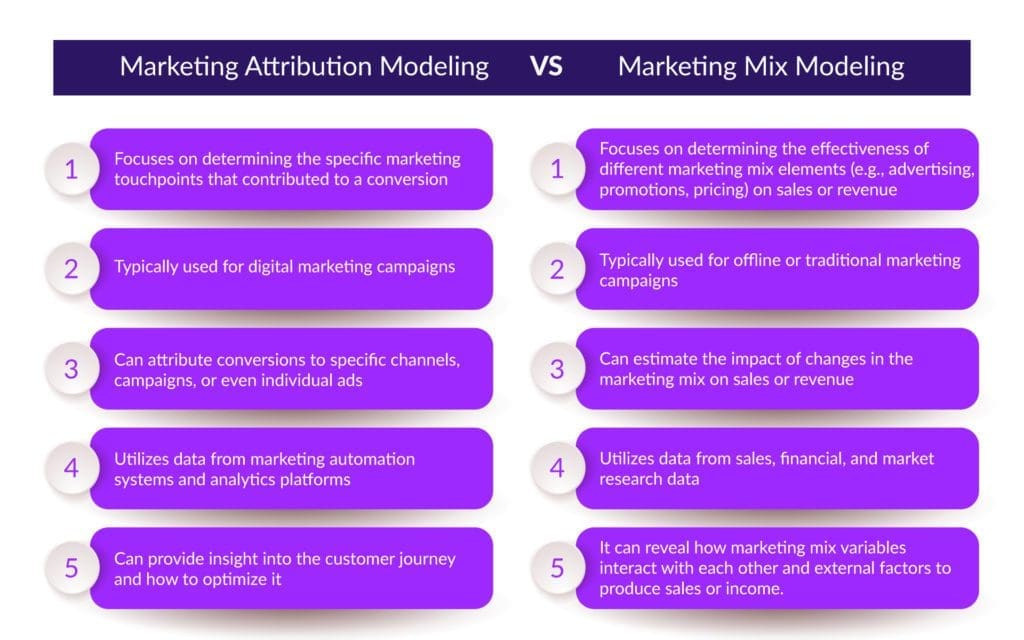If you want to be successful at marketing, you may no longer need qualities like these. Once upon a time, “marketing” was seen as a mysterious black box where money was thrown in the hope that sales would go up. In modern marketing, especially digital marketing, data, analytics, and figuring out the return on investment for marketing projects are at the top of the list. Executives in the marketing field feel like they must account for every cent spent on ads, sponsorships, blogs, videos, social media, influencers, and other marketing-related activities. This fixation could be helpful if it’s based on solid rules. As much as possible should be done to show how marketing costs lead to solid results like more sales and new leads. There are two main ways to deal with these changing barriers: Marketing Mix Modeling (MMM) and Marketing Attribution (MTA). But data availability is the most important thing to consider before choosing a method (or lack thereof). We will detail these two common solutions (Marketing Attribution vs Traditional Marketing Mix Modeling) to help determine which marketing measurement is best for you and your brand.
Table of Contents
What is Marketing Attribution Modeling?
“Marketing attribution” is the process of keeping track of and analyzing all of the marketing actions that led to a sale. Attribution tries to figure out which communication channels and messages were most important in getting someone to do what was wanted. Similarly, different attribution models, like multi-touch attribution, lift studies, temporal decay, and others, are used to do this. Modern marketers use these models to learn more about the customer journey and improve their marketing strategies. Advertising teams may improve their return on investment by targeting their campaigns more precisely to the preferences of individual customers with the help of these models that reveal when, why, and how people engage with brand messaging.
What is Marketing Mix Modeling?
Marketing mix models use multi-linear regression in their statistical analysis to establish a connection between a dependent variable, like sales or engagements, and a set of independent variables, such as advertising expenditure across channels. Multiple models should be compared to acquire the clearest picture possible of marketing’s results. Organizations using MMM should be selective in the data they collect. Because of the importance of having clean data, businesses will have to invest resources in consolidating information from internal databases, external sources, or both. Marketing mix models will often incorporate data from the previous two to three years to account for seasonal factors. As a result, businesses may put a monetary value on how effective their efforts across all forms of media were in bringing about the desired result (whether that be more engagement, conversions, etc.). With this information, marketers can determine how much their work is worth, plan, and guess how many sales they will make.
Marketing Attribution Model Pros And Cons
Marketing attribution is figuring out which marketing channels and strategies lead to the most sales and conversions. Likewise, businesses can improve their marketing mix and use their resources better. If they know how different marketing efforts affect the customer journey. However, using marketing attribution also has its pros and cons.
Pros
- Better allocation of resources: Marketing attribution helps businesses determine which channels and strategies are working and which aren’t. This can help increase the return on investment (ROI) and better use marketing budgets.
- Better understanding the journey of the customer: Attribution can help businesses determine how customers interact with their brand in different ways and through different channels. This can tell you a lot about improving the customer experience and journey.
- More transparency: Attribution makes it easier to track and measure different marketing efforts’ success. Furthermore, it makes it easy for teams to see which marketing channels and strategies are working and where to put their resources. It also helps teams work together better. Because they can easily share and talk about data and use it to make better decisions.
- Improved Targeting: Attribution can help businesses determine which parts of their audience are most likely to turn into customers so that they can focus their marketing efforts on those groups. This can make marketing more effective and improve the return on investment.
Cons
- Complexity: Attribution can give businesses useful information and help them make better decisions, but it also has some problems. Likewise, one of the biggest problems with attribution is that it can be hard and take a long time to set up and keep up with. This can make it hard for small or low-resource businesses to set up attribution systems. Also, the complexity of attribution models and the need for data expertise can make it hard for teams that aren’t tech-savvy to understand and make sense of the results.
- Limited Data: Attribution is based on information from different sources, which can be missing or wrong. Similarly, this can make it hard to get a clear picture of the customer journey and make good decisions about attribution.
- No standardization: There is no way to figure out who did what, and companies may use different models and methods. Due to this lack of standardization, it can be hard to compare how well different campaigns or channels are doing.
- Many options for customization: Attribution models are built on rules and assumptions, which can make them rigid in some situations. This can lead to wrong or misleading results, especially when dealing with customer journeys that are complicated or change over time.
Marketing Mix Modeling Pros And Cons
Marketing mix modeling (MMM) is a statistical method that uses a company’s past sales and marketing information to determine its best marketing strategies. Similarly, the model uses advertising, promotions, pricing, and distribution, among other things, to predict how changes in these factors will affect sales.
Pros
- Better ROI: MMM lets companies determine which marketing strategies work best and put their resources there. Also, By determining which marketing efforts lead to sales, companies can make the most of their money and focus on the best strategies.
- Decision making: MMM allows you to make decisions based on numbers, which can be helpful in situations where gut feelings or intuition may not be enough. With data-driven insights, companies can decide where to put their resources in a more informed way.
- Better Efficiency: MMM can help companies improve their marketing by helping them figure out which marketing strategies work best. Similarly, they can focus on the strategies that have been shown to increase sales and not waste money on those that don’t work.
- Better forecasts: MMM can be used to make good predictions about sales in the future. By looking at data from the past, the model can find patterns and trends that can be used to make future sales predictions.
Cons
- Data limitations: For MMM to work well, it needs a lot of information. If a company doesn’t have access to the right data or if the data isn’t very good, the model’s results won’t be as accurate.
- Presumptions: MMM is based on assumptions about how the different marketing variables affect sales. If these assumptions are wrong, the model may not be able to make accurate predictions.
- Complexity: MMM can be a complicated process requiring much knowledge and skill. This can make it hard for some companies to use the results and figure out what they mean.
- Limited viewpoint: MMM is based on historical data. Which means it only looks at how well something did in the past. Furthermore, it doesn’t consider things like economic downturns, pandemics, natural disasters, or other things that can’t be predicted.
Comparison of Attribution Modeling and Marketing Mix Modeling
Statistical techniques like attribution modeling and marketing mix modeling (MMM) can be used to look into and change marketing strategies. On the other hand, their goals and main focuses in marketing are different. You can use attribution modeling to determine which of your marketing efforts led to the most sales. Similarly, sponsored search, social media, email marketing, and other channels can be used to connect with people. Also, businesses can better use their marketing resources and focus their efforts if they know which channels give them the best return on investment. On the other hand, MMM looks at how marketing activities like advertising, promotions, pricing, and distribution affect sales to determine how to make these activities more effective. Furthermore, you can determine the best ways to advertise and predict sales growth. Also, this could be used to get the most out of your marketing budget and maximize your return on investment.
Table of Comparison
In the end, attribution and marketing mix modeling use statistical tools to look at marketing data. But they do so in different ways and with different goals. Likewise, marketing mix modeling looks at how different marketing inputs lead to individual sales results. Similarly, Attribution modeling looks at how different marketing touchpoints affect conversion rates. Both can be used to get the best return on investment from marketing activities, but they give different information. You can clearly see how well the marketing strategy is working. Following is a comparison table to understand the differences between attribution and marketing mix modeling. 
Takeaway
Knowing which channels are best for driving performance and allocating resources is helpful. However, statistical analysis can estimate how marketing inputs like advertising, promotions, and pricing affect sales or market share. It may assess a company’s marketing performance and suggest improvements. In conclusion, marketing mix modeling and attribution modeling can help evaluate marketing projects, but they do so differently. Marketing mix modeling looks at the strategy and inputs of a business. While marketing attribution modeling looks at each channel and strategy. Both methods could help businesses better understand how well their marketing is working and improve their strategies. Please also check out our blog post on Marketing Mix Modeling for more information.



